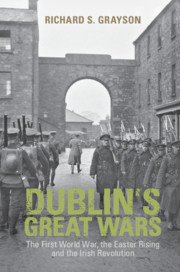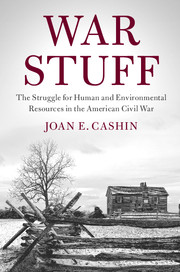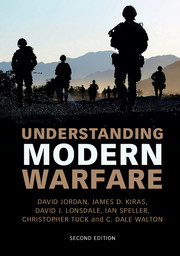Refine search
Actions for selected content:
15418 results in Military history
Contents
-
- Book:
- Environmental Histories of the First World War
- Published online:
- 16 August 2018
- Print publication:
- 23 August 2018, pp v-vi
-
- Chapter
- Export citation
18 - Crossovers
-
- Book:
- Dublin's Great Wars
- Published online:
- 17 August 2018
- Print publication:
- 23 August 2018, pp 283-299
-
- Chapter
- Export citation
Introduction
-
- Book:
- Dublin's Great Wars
- Published online:
- 17 August 2018
- Print publication:
- 23 August 2018, pp 1-7
-
- Chapter
-
- You have access
- HTML
- Export citation
Figures
-
- Book:
- Environmental Histories of the First World War
- Published online:
- 16 August 2018
- Print publication:
- 23 August 2018, pp vii-viii
-
- Chapter
- Export citation
3 - Dissolution before Dissolution
- from Part I - Europe and North America
-
-
- Book:
- Environmental Histories of the First World War
- Published online:
- 16 August 2018
- Print publication:
- 23 August 2018, pp 38-61
-
- Chapter
- Export citation
Appendix 2: - Military Service
-
- Book:
- Dublin's Great Wars
- Published online:
- 17 August 2018
- Print publication:
- 23 August 2018, pp 348-352
-
- Chapter
- Export citation
Acknowledgments
-
- Book:
- Environmental Histories of the First World War
- Published online:
- 16 August 2018
- Print publication:
- 23 August 2018, pp xii-xii
-
- Chapter
- Export citation

Dublin's Great Wars
- The First World War, the Easter Rising and the Irish Revolution
-
- Published online:
- 17 August 2018
- Print publication:
- 23 August 2018

Morale and Discipline in the Royal Navy during the First World War
-
- Published online:
- 17 August 2018
- Print publication:
- 30 August 2018

Environmental Histories of the First World War
-
- Published online:
- 16 August 2018
- Print publication:
- 23 August 2018

War Stuff
- The Struggle for Human and Environmental Resources in the American Civil War
-
- Published online:
- 16 August 2018
- Print publication:
- 30 August 2018

Understanding Modern Warfare
-
- Published online:
- 09 August 2018
- Print publication:
- 14 July 2016
-
- Textbook
- Export citation
10 - Creating a Cordon Sanitaire: US Strategic Bombing and Civilian Victimization in the Korean War
- from Part II - A Moving Target: Strategic Bombing and Civilians, 1916–2014
-
-
- Book:
- The Civilianization of War
- Published online:
- 20 July 2018
- Print publication:
- 09 August 2018, pp 196-220
-
- Chapter
- Export citation
Part I - Who Fights? Combatants, Mobilization and the Changing Nature of War
-
- Book:
- The Civilianization of War
- Published online:
- 20 July 2018
- Print publication:
- 09 August 2018, pp 21-162
-
- Chapter
- Export citation
Part Ia - The ‘Total War’ Era, 1914–1945
- from Part I - Who Fights? Combatants, Mobilization and the Changing Nature of War
-
- Book:
- The Civilianization of War
- Published online:
- 20 July 2018
- Print publication:
- 09 August 2018, pp 22-80
-
- Chapter
- Export citation
14 - The United Nations, Decolonization and Violence against Civilians in the French and British Empires
- from Part III - Civilian Protection and International Norms and Organizations: When and How Much?
-
-
- Book:
- The Civilianization of War
- Published online:
- 20 July 2018
- Print publication:
- 09 August 2018, pp 278-300
-
- Chapter
- Export citation
Contributors
-
- Book:
- The Civilianization of War
- Published online:
- 20 July 2018
- Print publication:
- 09 August 2018, pp ix-ix
-
- Chapter
- Export citation
15 - The ‘Protection of Civilians’: Peacekeeping’s New Raison d’Être?
- from Part III - Civilian Protection and International Norms and Organizations: When and How Much?
-
-
- Book:
- The Civilianization of War
- Published online:
- 20 July 2018
- Print publication:
- 09 August 2018, pp 301-319
-
- Chapter
- Export citation
13 - Human Rights Is the Continuation of War by Other Means: The United States and the Creation of the United Nations Human Rights Commission, 1945–1948*
- from Part III - Civilian Protection and International Norms and Organizations: When and How Much?
-
-
- Book:
- The Civilianization of War
- Published online:
- 20 July 2018
- Print publication:
- 09 August 2018, pp 260-277
-
- Chapter
- Export citation
4 - The Collapsing Civil–Military Divide in Wars of Decolonization: Two Case Studies from the Indochina War (1945–1954)
- from Part Ib - The Cold War and Decolonization, 1945–2000
-
-
- Book:
- The Civilianization of War
- Published online:
- 20 July 2018
- Print publication:
- 09 August 2018, pp 82-99
-
- Chapter
- Export citation
